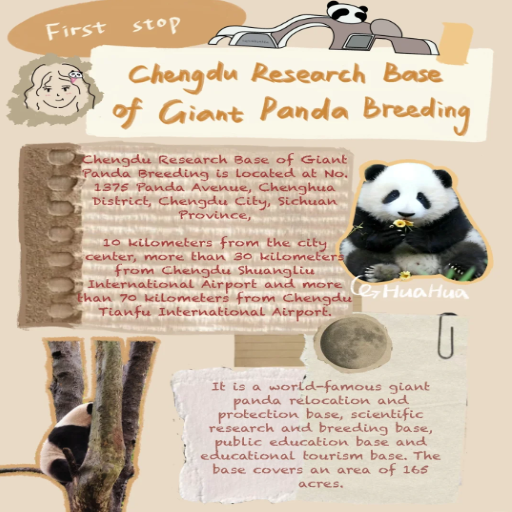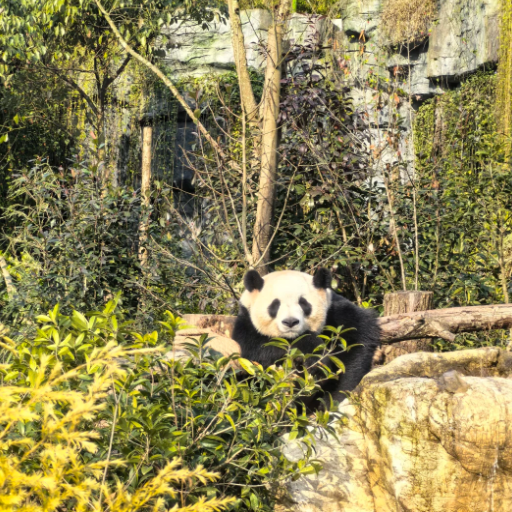Chengdu is home to the world’s most famous and loved bears! Chengdu’s Giant Panda Research Base is a must-see for wildlife and conservation enthusiasts. In the rest of this blog post, we’ll provide detailed information about the Base’s mission in panda conservation, practical information to make your visit unforgettable, and the breathtaking history of the Base and its contributions to how we’d all ‘bear’ it in preservation. We’ll offer the best panda tips with base information, times, tickets, and the most from this landmark tour, gentle giant lovers. Strolls in the heart of the beauty and passion for pandas that Greater Chengdu offers are guaranteed to be delightful for all travelers and panda enthusiasts alike. This guide ensures you make the most of your charming visit to the Giant Panda Research Base. The Chengdu Research Base of Giant Panda Breeding is a non-profit research institution and a conservation center located about 10 km (6 mi) northeast of Chengdu. Gaze in awe at these gentle giants and immerse yourself in their beautiful world of endless charm.
What is the Chengdu Research Base of Giant Panda?

What is the Chengdu Research Base of Giant Panda
The Chengdu Research Base of Giant Panda is known worldwide for conserving, breeding, and conducting research on giant pandas. Founded in 1987 in Chengdu, China, it aims to save the species and its environment. The Base seeks to protect the pandas while enabling research, education, and collaboration on a broader scale. It is home to numerous pandas of all ages, providing an excellent opportunity for people to witness their behavior and the surrounding conservation activities.
Understanding the Research Base and Its Mission
The Chengdu Research Base is focused on the long-term conservation objectives of giant pandas under its care. Its mission encompasses advanced breeding techniques, habitat protection, and research to better understand panda health and reproduction. For instance, the base uses artificial insemination, which improves the probability of pandas reproducing in captivity because of their problems with mating.
Outstanding milestones are the comprehensive care protocols developed to monitor the nutrition, temperature (which should be bacterially controlled between 20 and 24 degrees Celsius), and natural exposure of newborn pandas. The base is also well equipped with veterinary facilities, which are crucial in restraining babies for health assessment using noninvasive measures of stress and health.
Furthermore, the Research Base focuses on public education and awareness through interactive exhibits and workshops to inspire advocacy. It works globally on genetics and habitat restoration research projects to secure the future of giant panda populations. These efforts highlight the base’s proactive strategy in dealing with the ecological and biological problems that pandas face today.
History and Achievements of the Chengdu Panda Base
The Chengdu Research Base of Giant Panda Breeding started in 1987 on a mission to help six rescued giant pandas. Today, it is one of the most critical facilities in the world for giant panda conservation, scientific research, education, and public outreach. As of 2023, the base has a significant panda population of over 200 and has become one of the world’s largest and most successful breeding centers.
One of the base’s most significant achievements is manipulating artificial breeding techniques. This has significantly increased the survival rate of giant panda cubs, which now exceeds 95%. Furthermore, the base’s research program has improved our understanding of panda behavior, genetics, and disease control.
The base also focuses on restocking habitats and repopulating pandas in the wild. One of its most notable achievements came in 2003 when the base successfully reintroduced a captive-bred giant panda into the wild. Now, the facility is constantly working on improvements for sustainable panda habitat reintegration, along with other conservation programs worldwide.
The Chengdu Panda Base has visitors worldwide to see its displays and programs within its educational base. These features include the biology of the panda and conservation efforts, which use interactive panda displays to help merge scientific progress with public aid for environmental issues. The center’s devotion to endangered species protection goes beyond pandas and helps the entire ecosystem’s health within the species’ natural range.
Why is Chengdu a Key Location for Giant Panda Breeding?
Due to the ecological, geographical, and scientific combination, Chengdu is ideal for giant panda breeding. It is located within the Sichuan Province, which is at the center of the panda’s habitat, providing a climate and environment similar to the conditions in the wild. The region also has vast bamboo forests, which make up 99% of the panda’s diet. Furthermore, Chengdu has world-class research and breeding centers like the Chengdu Panda Base, which use high technology and professional skills for successful reproduction and rehabilitation programs. Essential features include artificially controlled breeding areas, genetic monitoring to prevent inbreeding, and favorable temperature and humidity to natural habitats.
How Can I See Pandas at the Chengdu Giant Panda Base?

How Can I See Pandas at the Chengdu Giant Panda Base
Visiting the Chengdu Panda Base requires minimal effort with surrendered maximum output as a reward. The base is open daily, and ticket sales are offered online and at the entrance. Make sure to show up early, ideally between 8 am and 10 am, to see pandas feeding and playing. In addition, pandas look for other species, including the nursery area where the tiny cubs are stored. For those interested in learning more about the conservation processes and panda behavior, in-depth guided tours are also offered.
Best Times to Visit the Panda Base
The optimal time to visit the Panda Base is usually between 8 am and 10 am, as most pandas are playful and most active at this time. Next, consider the seasons. Springtime (March to May) and Fall (September to November) have excellent weather conditions, making this an ideal time for a visit. Seeing a panda in these conditions is an experience you will never forget. Weekdays are always a better option than weekends because weekends can get crowded. Following these recommended times, you will make the best of your visit.
Guided Tours and Experiences at the Panda Research Base
Visitors are further encouraged to learn through a variety of interactive experiences and guided tours centered around pandas offered at The Panda Research Base. In-person tours with the experts help to delve deeper into the biology of the panda, conservation efforts, and habitat preservation programs. These tours usually range between 1 and 2 hours, and international guests can avail of these services in English and Mandarin.
The base offers volunteer programs that include panda care routines such as feeding, cleaning, and preparing food for the pandas, which make the visit more engaging. A donation or participation fee is often required for funding to advance the booking of these sessions, which support ongoing conservation efforts. For convenience and safety, these programs are only available to children over 12 and usually last half a day to a full day.
Specialized topics include the reproductive difficulties of pandas and genetic research overlapping species conservation, which can be found in educational exhibits and presentations. While the base has rules to protect the welfare of the pandas and other animals, specific areas are set aside for tourists to take pictures with pandas. Most parts of the base allow photographs as long as the flash option is turned off, which helps prevent startling the animals.
With advanced booking, visitors can have unique experiences, such as behind-the-scenes tours at panda cub nurseries and research labs. Group tours usually benefit from reduced prices when ordered well ahead of time online.
For details:
- Opening Hours: 7:30 AM – 6:00 PM daily
- Best Tour Duration: 3-4 hours for a comprehensive visit
- Tour Fees (Standard Access): Between $10-$20 (subject to seasonal adjustments)
- Volunteer Program Fee: Approximately $100-$150 per person
- Peak Visitor Capacity: 20,000 individuals per day (to maintain crowd control)
These well-structured experiences ensure a memorable visit and contribute significantly to the center’s panda conservation and public education mission.
Spotting Baby Pandas and Red Pandas
Seeing baby pandas and red pandas is a breathtaking yet challenging task that requires lots of patience and luck. Baby pandas can be seen in their nurseries from August to November when they are born. During the same time, red pandas can be spotted relaxing in the cooler parts of their habitat. To improve your chances of spotting these animals, visit early in the morning, as both species are active. If you happen to be a visitor, make sure to capture the correct distances of 10-20 feet (3-6 meters) to ensure your safety and the protection of the animals. For everyone else, always turn off the noise and avoid sudden movements to make the environment more peaceful for the animals.
What Are the Main Features of the Panda Breeding Center ?

What Are the Main Features of the Panda Breeding Center
The Panda Breeding Center has advanced breeding methods and habitat simulation to aid in preserving and researching giant pandas. Some key characteristics are specialized enclosures that house pandas and have the appropriate surroundings like vegetation, climbing structures, and pools for the panda’s nature. The center also has modern veterinary clinics and other medical facilities to closely monitor the pandas’ health and provide medical care when needed. Newborn cubs receive the best possible care in a nursery area designed to achieve this, while other research laboratories concentrate on genetic conservation studies. In addition, different spaces are designed to educate the public about the biology, behavior, and conservation of pandas. These elements work towards the center’s vision of saving an endangered species that needs protection.
Exploring the Panda Enclosure
The Panda Enclosure has been intricately crafted and developed to enhance pandas’ comfort by allowing them to hide in treetops. It includes an area filled with bamboo where the pandas can exercise, feed, and relax climbing structures, as well as a water feature. Humidity is kept between 50-70%, and temperature is set between 20 and 25 degrees Celsius, which are the conditions in which the panda from China would thrive.
The enclosure has fresh bamboo, high-fiber biscuits, and fruits to fulfill their dietary requirements, which care for the pandas’ nutrition. Roughly 99% of a panda’s diet is bamboo; they can eat up to 38 kilograms (84 pounds) daily. Their health is tracked using advanced monitoring systems and supplemented by regular vet checkups.
The enclosure also includes observation decks from which visitors can safely appreciate the animals from afar without disturbing the pandas. More educational panels and interaction displays also improve visitors’ experience by teaching about pandas, conservation, and research projects. The center’s dedication to understanding and preserving this iconic species by combining modern design, technology, and education exemplifies this.
Meet the Panda Keeper and Learn About Care Programs
As a panda keeper, my core task is to ensure the well-being of the pandas, which come from a well-maintained habitat, good health, and proper nutrition, including bamboo, fruit, and special nutrients cakes. My day begins with cleaning their enclosures, providing fresh food, and observing their behaviors to look for stress or signs of illness.
Care programs emphasize the integration of health supervision, enrichment activities, and breedings. Enrichment includes the provision of toys, bamboo sculptures, and exercises that evoke natural behavior, which is vital for their physical and mental health. Essential points we adhere to include a temperature between 16-24 degrees Celsius, relative humidity of 50-60%, and a minimum enclosure area per panda of 400 square meters. These parameters are essential for simulating their natural habitat and conserving the species as a whole.
How Does the Giant Panda Breeding Research Base Contribute to Conservation?

How Does the Giant Panda Breeding Research Base Contribute to Conservation
The Giant Panda Breeding Research Base uses advanced research and breeding programs to contribute to conservation efforts. It aims to increase the panda population with limited genetic variation by focusing on successful captive breeding. The base also has programs for preserving and restoring habitats so that pandas can safely live in the wild. Furthermore, the base runs educational programs aimed at raising attention for conservation and works together with other countries to protect this species. Because of these efforts, the base makes essential strides towards global conservation targets.
Research Initiatives at the Chengdu Panda Base
The Chengdu Panda Base conducts in-depth research projects to solve specific problems related to the conservation of giant pandas. These efforts include examining panda behavior, physiology, and genetics to enhance breeding and health outcomes. For example, researchers employ reproductive techniques like artificial insemination, significantly increasing success rates in captive breeding programs.
Furthermore, other genetic procedures are performed to minimize inbreeding and retain a healthy genetic pool. The base ensures that pandas’ nutritional needs and ability to digest food are cared for. They ensure that the pandas receive the nutrition they need biologically, including an estimated 20–40 pounds of bamboo daily. Moreover, researchers put more effort into disease prevention and veterinary care by studying common diseases and using a preemptive approach to healthcare needs.
In addition, the base tracks solar-powered GPS collars and uses remote cameras to understand the areas used by free-ranging pandas. This information assists in restoring habitats to ensure that ecosystems can sustain wild panda populations by providing sufficient bamboo and cover. These projects initiated from research findings have proven crucial to achieving long-term conservation success.
The Role of Panda Research in Global Conservation Efforts
Panda research helps address the issues of giant pandas and their habitats, thus playing a crucial part in global conservation efforts. These programs depend on panda studies, which include behavior, reproduction, and ecological necessities so that remedial action is taken toward population recovery and habitat restoration. Various research bodies, including the China Conservation and Research Center for the Giant Panda (CCRCGP) and WWF, work together to balance the sustainable growth of captive and wild panda populations.
The study of panda reproduction is also significant, and it proves to be quite a challenge due to low fertility rates and brief breeding seasons. The success rate has seen improvement due to artificial insemination procedures and genetic testing. For example, monitoring reproduction hormone levels increases the chances of many successful offspring. Data points to that genetic diversity has increased due to captive breeding programs, evident in the ever-growing number of pandas globally. The population was estimated to be 1,596 in the wild in 2004, and recent surveys show more than 1,864 pandas.
Another significant area of focus in panda research is the preservation of its habitat. Pandas in the wild need habitats with dense bamboo forests because bamboo makes up 99% of their diet. These corridor-based habitat restoration projects attempt to solve the problem of forest fragmentation. They use modern GPS trackers and GIS ecological mapping, guaranteeing that the restoration will benefit panda movement and resource use quantitatively.
Bamboo forests must cover more than 30-35% of panda habitats, and the wild population should grow more than 1% annually for the panda bear to be viable in the long run. Additionally, there has been a significant increase in veterinary care and husbandry practices, as demonstrated by managed captive programs, which have given newborn pandas survival rates above 80%.
In addition to saving one of the world’s most adored species, panda research is crucial for addressing the ecological imbalance, creating awareness, and developing policy in conservation biology.
What are other places in China where you can see pandas?

What are other places in China where you can see pandas
Besides the well-known research bases in China, visitors keen on seeing pandas in their protected or natural environments have other excellent choices. The Wolong National Nature Reserve, part of the Sichuan Giant Panda Sanctuary, combines conservation, education, and immersive experiences. The Dujiangyan Panda Base specializes in rehabilitation and semi-wild training practices with active spectator opportunities. Another notable site is the Gengda Panda Center, which is well known for its calm surroundings and concentration on breeding and research. Furthermore, the Chongqing Zoo and the Beijing Zoo exhibit pandas in urban settings, which is perfect for those who do not have ample time but want to enjoy the beauty of these wonderful animals. All these places demonstrate the effort China makes towards panda conservation and, at the same time, ensuring visitors have a wonderful experience.
Overview of the Dujiangyan Panda Base
The Dujiangyan Panda Base is a famous center for rescue, rehabilitation, and research activities in the Sichuan Province of China. The China Conservation and Research Center for the Giant Pandas runs this facility, which is essential to the pandas’ conservation efforts. The base area covers 51 acres and is calm and natural, ideal for sick pandas, post-medical care, training, and some domestic wild adjustment.
Structured into various functional sectors, the base includes veterinary hospitals and semi-wild enclosures that aim to provide captive animals with an environment as close to the natural habitat as possible. People who come to the base can participate in engaging activities like educational excursions and the much sought-after ‘Panda Keeper for a Day’ program, where they help the experts feed and care for the pandas. Notably, the center at Dujiangyan primarily focuses on tame panda breeding for further release into nature, which guarantees their long-term conservation.
The most important features of this program are the new medical facilities intended for health supervision, the modern filtration units for purifying drinking water, and the enclosures simulating the ecosystem of the pandas, particularly the boom regions. The base also strongly focuses on conserving clean technologies to reduce environmental impact, which, from the mission’s point of view, is essential for preserving wildlife.
Comparing the Beijing Zoo and Chengdu Zoo
In my perspective, the Chengdu Zoo and the Beijing Zoo are both unique in scope and contribute to the conservation of animals. Being one of the oldest zoos in China, the Beijing Zoo spends the bulk of its resources on educating the public, and its collection of animals, including a panda exhibit, is pretty encompassing. It extends over 200 hectares and combines traditional Chinese gardens with facilities that house animals, yet the Chengdu facilities are modern. Likewise, the Sichuan Chengdu Zoo is smaller, but the fact that it is located in the home region of the giant panda gives it a significant advantage in panda conservation. Also, it has modern facilities and promotes breeding practices.
Key Aspects :
- Beijing Zoo :
- Covers approximately 219 acres with spacious enclosures.
- Utilizes a multi-zone temperature regulation system for species from varied climates.
- Houses an extensive collection of over 450 species.
- Chengdu Zoo :
- Encompasses more focused habitats, especially bamboo-rich areas for pandas.
- Incorporates energy-efficient filtration systems for enclosure ponds.
- Integrates advanced veterinary care facilities with a focus on local wildlife.
While both are exceptional, Chengdu Zoo’s location and systemic expertise in caring for pandas give it an advantage in this conservation area.
References
Chengdu Research Base of Giant Panda Breeding
Frequently Asked Questions (FAQ)
Q: Where is the best place to see the pandas in Chengdu?
A: The best place to see the pandas in Chengdu is the Chengdu Giant Panda Breeding and Research Base. It is renowned for its efforts in conserving and researching giant pandas and red pandas.
Q: How can I get to the Chengdu Giant Panda Breeding Center?
A: Take the metro to Panda Avenue and a short taxi ride to the Chengdu Giant Panda Breeding Center. It is easily accessible and a popular destination for visitors wanting to see pandas in Chengdu.
Q: What can I expect to see at the Chengdu Panda Center?
A: At the Chengdu Panda Center, you can see giant pandas and red pandas, visit the conservation education center, and learn about the ongoing research and conservation efforts conducted at the research facility.
Q: Are there panda tours available at the giant panda research base?
A: Guided panda tours are available at the giant panda research base, offering insights into the lives of pandas in China and the work being done to protect these beloved animals.
Q: Can I hold a panda at the Chengdu Giant Panda Breeding Center?
A: Holding a panda is generally not allowed, as the center focuses on the well-being and conservation of pandas. However, visitors can take a panda photo with strict guidelines to ensure the animals’ safety.
Q: What is the most significant number of pandas I can see once in Chengdu?
A: The Chengdu Giant Panda Research Base houses many pandas, making it one of the best places to see a significant population of giant pandas and red pandas in one location.
Q: Why is the Chengdu Panda Base important for panda conservation?
A: The Chengdu Panda Base is crucial for panda conservation. It serves as a research facility focusing on breeding, habitat preservation, and public education about giant and red pandas, helping to ensure their survival.
Q: What are the visiting hours for the Chengdu Giant Panda Breeding Center?
A: The Chengdu Giant Panda Breeding Center typically opens from early morning to late afternoon, allowing visitors ample time to see the pandas and explore the panda research center.
Q: Is there a red panda enclosure at the Chengdu Panda Center?
A: Yes, the Chengdu Panda Center includes a red panda enclosure, where visitors can observe these charming creatures alongside the giant pandas.
Q: How is the Chengdu Giant Panda Research Base involved in global panda conservation efforts?
A: The Chengdu Giant Panda Research Base collaborates with international organizations to enhance global panda conservation efforts through research, breeding programs, and educational initiatives.